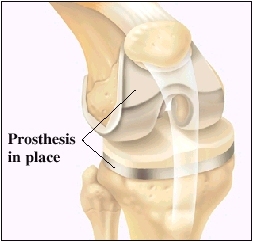Total Knee Replacement
During total knee replacement surgery, your damaged knee joint is replaced with an artificial joint (called a prosthesis). This surgery almost always reduces joint pain and improves your quality of life.

The parts of the prosthesis are secured to the bones of the knee. Together they form the new joint.
Before Your Surgery
You will most likely arrive at the hospital on the morning of the surgery. Be sure to follow all of your doctor's instructions on preparing for surgery.
-
You should stop eating or drinking 10 hours before surgery.
-
If you take a daily medication, ask if you should still take it the morning of surgery.
-
At the hospital, your temperature, pulse, breathing, and blood pressure will be checked.
-
An IV (intravenous) line may be started to provide fluids and medications needed during surgery.
The Surgical Procedure
When the surgical team is ready, you'll be taken to the operating room. There you'll be given anesthesia to help you sleep through surgery, or to make you numb from the waist down. Then an incision is made on the front or side of your knee. Any damaged bone is cleaned away, and the new joint is put into place. The incision is closed with surgical staples or stitches.
When to Call Your Doctor
Once at home, call your doctor if you have any of the symptoms below:
-
An increase in knee pain
-
Pain or swelling in a calf or leg
-
Unusual redness, heat, or drainage at the incision site
-
Fever of 101.0°F or higher
-
Trouble breathing or chest pain (call 911)
After Your Surgery
After surgery, you'll be sent to the PACU (postanesthesia care unit). When you are fully awake, you'll be moved to your room. The nurses will give you medications to ease your pain. You may have a catheter (small tube) in your bladder. A CPM (continuous passive motion) machine may be used on your knee to keep it from getting stiff. An SCM (sequential compression machine) may be used to prevent blood clots by gently squeezing then releasing your leg. Soon, healthcare providers will help you get up and moving.








